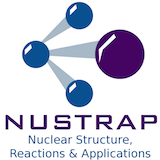A nuclear reaction is a rather general term to describe the most
fundamental phenomenon that Nuclear Physics deals with. The baby
steps of Nuclear Science were completed on investigations of nuclear
reactions with alpha particles emitted from radiation sources, such
the Ra-226 alpha source Rutherford used to discover the atomic
nucleus.
Nuclear Reactions are the most essential tools to probe nuclear
matter and obtain critical information on new phenomena. The
structure of isotopes is investigated via reactions that force the
nuclei to shake and reveal their essence. There are several types of
reactions and most of them deal with transmutation of nuclei, where
the strong and weak nuclear forces are rulers of the
phenomena. However, electromagnetic interactions between beams and
targets are also considered nuclear reactions; a very common example
is Coulomb excitation, commonly used to study the electromagnetice
properties of nuclei.
With the advent of radioactive beams, scientists use reactions
between exotic species to investigate the extremes of the nuclear
chart. In that direction, nuclear astrophysics is a subject that has
been boosted significantly in recent years. Exotic probes and
unstable systems can be now used to explore phenomena that drive the
production of nuclear fuel in distant stars and trace down the
birth, life and death of cosmic objects. Universal matter is created
and transmutes via certain paths of interconnected nuclear reactions
that may take millions of years to complete. Since this information
is very hard to reproduce at the lab, it is desirable to measure the
probability of a nuclear reaction in a large network by means of
individual cross section measurements.
Moreover, nuclear reactions are in the core of the nuclear
analytical techniques with a great number of applications to several
scientific fields, such as geochemistry, nanoscience, biology
etc. Techniques such as Rutherford BackScattering (RBS) or Nuclear
Reaction Analysis (NRA) have become common tools to obtain the
thickness, stoichiometry, density and several other properties of
samples. Applications are virtually endless.
The NuSTRAP has several joint activities in experiments with nuclear
reactions, focused on three main directions: a) investigate the
dynamics of nuclear reactions via spin polarization measurements
b) understand the role of exotic species in the star formation and
c) use nuclear reactions to study the role of natural elements in
the geochemical and environmental cycle.
